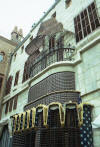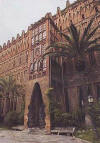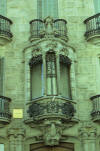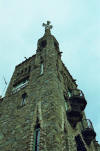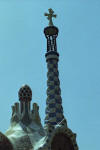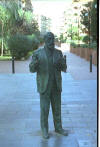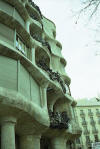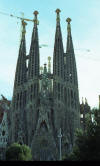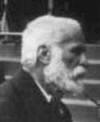Gaudi Chronology (1852-1926)
1852 – Antoni Placid Gaudí i Cornet is born June 25 in Reus according to some biographers and according to other in Riudoms – a village next to Reus.
His parents were Francesc Gaudí i Serra (born in Riudoms) and Antònia Cornet i Bertran (born in Reus).
The profession of his father, boilermaker, will influence Gaudí according to he himself recognizes, in his spatial conception, in his interest by the decorative elements and in his manual ability.
1860 – Gaudí carries out his first studies in the school of the master Berenguer of Reus (father of Francesc Berenguer – 1866-1914 – future architect assistant of Gaudí).
1863 – Gaudí studies the degree in the Escoles Pies of Reus.
1866 – Josep Maria Bocabella, the promoter of the temple of the Sagrada Família, sets up the Association of Saint Joseph Devotes, with the basic objective to build the temple.
1867 – Along with Eduard Toda and Josep Ribera, he publishes in Reus a handwritten magazine "El Arlequín" (The Harlequin) Gaudí carrying out the drawings.
1868 – He comes to live in Barcelona with his brother and starts the higher studies in the Institut d’ Ensenyament Mitjà (Half level Teaching Institute) as free student.
1869 – He carries out preparatory studies in the Sciences Faculty to be prepared to access the University of Barcelona.
All his family comes to live in Barcelona.
Along with Eduard Toda and Josep Ribera, he initiates a restoration project for the Monastery of Poblet (with its royal tombs), that will be culminated some years later by Eduard Toda.
1873 – He initiates the studies in the section of Architecture of the Provincial School of Barcelona.
He begins to collaborate with Francesc de Paula Villar, Martorell and Sala.
To pay his studies, he works with Josep Fontseré in the project of the Park of the Ciutadella, especially the monumental source, the Born Market and other projects.
1874 – Gaudí is presented in a contest for the execution of a pantheon for Anselm Clavé. Gaudí and other competitors are to be withdrawn in favour of the project of Lluís Domènech i Montaner and Josep Vilaseca.
1875 – He carries out the water tower for the Park of the Ciutadella reservoir.
He does the military service.
1876 – The mother of Gaudí and his brother Francesc died, what originates a crisis that affects to his ideological orientation.
He works as a machinery draughtsman in the firm Padrós i Borràs.
He continues also his contribution with the architect Francesc de Paula Villar, carrying out as draughtsman the project of the chapel of the virgin and the apse of the Monastery of Montserrat.
Also he carries out various school projects.
1877 – Gaudí is presented to a contest called by the School of Applied Arts of Ateneu Barcelonès, in a project oriented to the industry. Earns no prize.
Santa Teresa School (*published under "Edicat" authorization)
Catllaràs Villa
(*Author Joan Ribera -published under "Amalgama" authorisation)
1878 – This is a crucial year in the life of Gaudí, because:
In January 4 he does his final exam as architecture student.
In March 15 he obtains officially his degree of architect.
He knows Eusebi Güell i Bacigalupi – count of Güell – for whom he will build a very important part of his work.
He carries out a series of works that already begin to have a certain importance:
The project of his own table of work.
He designs the furniture for the chapel of the pantheon of the marquis of Comillas.
By assignment of the mayor of Barcelona, he carries out the lampposts of the Plaça Reial.
By assignment of the merchant in gloves Esteve Comella, he carries out a showcase in iron forged, wood and glass for the presentation of his products in the World’s Fair of Paris.
He builds a theatre in Sant Gervasi.
He builds a housings building for the Workers Cooperative of Mataró.
He builds a sale of flowers kiosk.
In the summer of this same year he begins to write a newspaper on architecture that is known like "Els Manuscrits de Reus" (The Reus Manuscripts).
1879 – His sister Rose dies, Gaudí will take in charge her psychic diminished daughter to his death.
He enters to be part of the executive of the Catalan Association for Scientific Excursions.
He carries out works of decoration in the convent of Jesus-Maria of Sant Andreu de Palomar and in the pharmacy Gibert in Canuda street (at present vanished).
He initiates the first studies to build the Vicens House.
1880 – He projects the altar of the chapel of the school of Jesus-Maria and also the lampposts of the Passeig de la Muralla (Walk of the Wall) – with names of Catalonian admirals – in Barcelona, that will not be built.
He carries out some visits to monuments and populations of the country: Santa Maria del Mar (an impressive gothic church in Barcelona), Vilafranca del Penedès, Olesa de Bonesvalls two Catalan towns.
He becomes a member of the Industrial Arts Exhibition organizer Committee, inaugurated December 21.
1881 – He presents a project not accepted, to a contest to build a Casino in Donostia (San Sebastián – Basc country).
He carries out a building with lampposts and paintings of Alexandre de Riquer, to decorate the Palace of Sobrellano in Comillas because a visit of the king Alfons XII.
He designs the altar of the chapel of the school of Jesus-Maria in Tarragona.
He carries out the plans of the factory of the Workers Cooperative of Mataró.
1882 – Gaudí works, as assistant of the architect Joan Martorell, in the projects of the churches of the Jesuits of Casp and the Saleses of Sant Joan Promenade in Barcelona.
He carries out the project of a shooting box in the count of Güell properties in the Garraf, who was never build.
The month of March the foundation stone of the Sagrada Família temple is lay under the direction of the architect Francesc de Paula Villar i Lozano. Gaudí was not still linked to the project.
November 3, Gaudí succeed Francesc de Paula Villar i Lozano as the architect of the Sagrada Família, under the suggestion of the architect Joan Martorell.
During an encounter of Catalonian artists, Gaudí visits the Monastery of Poblet.
1883 – Gaudí participates in an encounter of Catalans of both-sides of Pyrenees in Elna (Rosselló – North of Catalonia, today under French administration) with Verdaguer, Marià Aguiló, Àngel Guimerà, Masriera, etc. Project of a chapel of the Santíssim Sagrament (Most Holy Sacrament) in the parish church of Alella, never carry out.
Start of the construction of the Vicens House.
Start of the construction of the villa El Capricho in Comillas.
1884 – March 28, Gaudí signs his first official document as the architect of the Sagrada Família.
He begins the reform of the Güell property in Pedralbes (Barcelona), finished in 1887.
1885 – It is declared in Barcelona an epidemic of cholera. Gaudí comes to Sant Feliu de Codines, a village near Barcelona.
He carries out the first project of the plant of the Sagrada Família.
He carries out an altar, a reliquary and a sacrarium for the Sagrada Família promoter Josep Bocabella.
1886 – Gaudí signs the project of the Güell Palace and takes in charge of its construction.
He finishes the construction of the seven chapels of the Crypt of the Sagrada Família.
1887 – Gaudí is entrusted to restore the Saló del Consell de Cent (Lounge of the Hundred Council – who is a gothic ceremonial lounge in the Barcelona Town Hall -) and of the main stairs of access of the City Hall of Barcelona, projects that will not be carry out.
In February he accepts the assignment of the new Astorga Episcopal Palace.
He builds the Sagrada Família vicarage, in which he prepare his workspace and where he will live the last years of his life.
He finishes the works of the Güell property.
1888 – He exposes some projects in the World’s Fair of Barcelona and in its maritime section, he carries out the stand of the Transatlantic Company.
He finishes the Vicens House.
1889 – The month of March he substitutes the previous architect in the works of enlargement of Santa Teresa School in Ganduxer street of Barcelona.
The Güell Palace is finished.
The month of December, Gaudí signs the plans of the Botines House to be build in León (Spain).
He carries out the altar of San José de Calasanz in the Basilica of Montserrat.
Some authors mention a trip (not documented) of Gaudí to Tanger and Malaga to study the project of a building for the Franciscan Missions, that it will never carry out.
1892 – The construction of the Nativity façade of the Sagrada Família begins.
Between January and September, the Botines House in León is built.
1893 – The bishop of Astorga Joan Baptista Grau i Vallespinós dies, Gaudí, faced to the Diocesan Council Meeting, renunciation to continue the works of the Episcopal Palace.
The crypt and the apse of the Sagrada Família are finished.
Gaudí carries out the project of the Colònia Güell church in Santa Coloma de Cervelló
1895 – The works of the Güell Cellar are initiated in Garraf.
The construction of the cloister of the Sagrada Família is initiated.
Gaudí design a project, not finally carried out, for the family Güell for the construction of a sepulchral chapel in Montserrat.
1897 – Josep Fontseré one of the first masters of Gaudí dies.
1898 – The works of the Calvet House begins, that building will be the prize winner of the City Council award to the better building of the year.
He enters in the Cercle Artistic de Sant Lluc, an artists association devoted to the promotion of the arts from a catholic point of view. This association was founded by the brothers Joan and Josep Llimona in 1893.
1900 – Reformation of the facade of the house Pere Santaló in the Nou de la Rambla street in Barcelona.
Decoration of a lounge of the Coffee Torino in the Passeig de Gràcia in Barcelona.
He begins the urbanization works of the Park Güell.
He begins the construction of the Bellesguard House.
He carries out a project for the monumental Way of the Cross of Montserrat (first Mystery of Glory).
He finishes the works of the Calvet House.
1901 – He decorates the house of Isabel Güell marchioness of Castelldosrius.
He carries out the fence of the Miralles Property.
Termination of the Güell Cellar in Garraf.
1902 – He begins the construction of the Catllaràs Villa in La Pobla de Lillet.
1903 – He travels to Majorca to study the works of restructuring of the interior of the Majorca Cathedral, that the bishop Campins entrusts him, works developed through 10 years and remained uncompleted.
He carries out in contribution with Rubió and Sugrañes a project for the façade of the Sanctuary of the Mercy of Reus, that was not carried out.
He celebrates the exhibition "Hispania" of furniture designed by himself in the Rambla of Barcelona.
He begins the construction of the Artigas Gardens in La Pobla de Lillet.
He finishes (probably) the construction of the Catllaràs Villa.
1904 – He initiates the project of total restructuring of the Batlló House.
He projects and begins the construction of a villa for the painter Lluís Graner, remaining an uncompleted project.
He projects a part of the movies Mercé in the Rambla of Barcelona.
1905 – Gaudí is going to live to the house projected by his disciple Francesc Berenguer in the Park Güell. Gaudí projects La Pedrera.
1906 – Gaudí begins the works of La Pedrera also known as Milà house.
October 23 his father Francesc Gaudí i Serra dies at the age of 93 in the Gaudí House of the Park Güell in which he lived with his son, since the previous year.
The Batlló House receives the prize of the Barcelona City Council to one of the better constructions of the year.
1907 – He projects a monument to Jaume I in the Kings square of Barcelona, but that monument will never carry out.
The Barcelona City Hall puts difficulties to the works of La Pedrera, because Gaudí does not accept the municipal Ordinances.
1908 – Start of the works of the Colònia Güell Crypt .
He presents the not accepted idea, for the execution of a monumental project next to the Santa Àgata chapel in Barcelona that would have to be visible from all the city.
1909 – Sketches of the project of a skyscraper hotel in New York.
Construction of the Sagrada Família Schools.
The Bellesguard house is finished.
1910 – Gaudí exposes gypsum models his works in the Grand Palais of Paris since April 15 to June 30, with a great success.
He is entrusted partly of a project to raise in Vic a monument to Jaume Balmes, that will never carry out. The works of La Pedrera are finished.
The works of the Artigas Gardens are finished.
1911 – Gaudí sick of fevers of Malta. To be cured he comes to Puigcerdà (North of Catalonia, in the Pyrenees mountains).
He does his testament.
1912 – January 11 its psychical diminished niece Rosa Egea i Gaudí dies at age 37. Gaudí had taken care of her, since the death of her mother.
Gaudí carries out some pulpits for the church of Santa Maria de Blanes (La Selva) that were destroyed in 1936.
1914 – The works of the church of the Colònia Güell are interrupted as well as the ones of the Park Güell that has failed in its economic side.
Gaudí rejects new assignments and concentrates on the construction of the Sagrada Família.
1915 – Gaudí still travels to Manresa to study an eventual Cathedral reform.
The tests of the Sagrada Família tubular bells are done.
1916 – He does a study on the possibility to create tombs inside the Sagrada Família.
1917 – The Passion Façade of the Sagrada Família is designed, including a monument to the Bishop Torres i Bages.
1918 – Eusebi Güell i Bacigalupi, count of Güell, that had been the great sponsor of Gaudí, died in his residence of the Park Güell.
Gaudí carries out a sketch for a monument to Prat de la Riba – first president of the Mancomunitat de Catalunya – in Castellterçol.
1920 – Le Corbusier visit in Barcelona the works of the Sagrada Família, that he qualifies as masterpiece.
1923 – He carries out some studies for the chapel Calvet in Torelló.
The models of the nave and of the ceiling of the Sagrada Família are carried out.
1924 – Gaudí is under arrest September 11 – Catalonian national holyday – to attend in the church of the Just i Pastor Saints to the mass in memory of the Catalonian patriots and to refuse to speak in Castilian (Spanish) language to the police.
1925 – He come to live inside the precinct of the Sagrada Família to closer follow the works.
A bell tower and the Nativity facade of the Sagrada Família are finished.
1926 – Gaudí is knocked down in the crossing of the Gran Via with the Bailen street of Barcelona by a tramway June 7 . In consequence of the injuries, Gaudí dies on the 10 in the Hospital of the Holy Cross and is buried in the Crypt of the Sagrada Família on the 12.

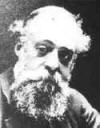
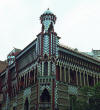
_small.JPG)

